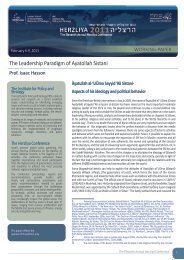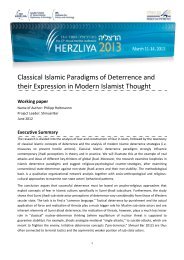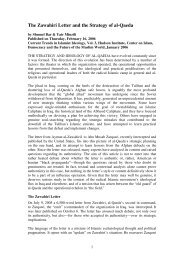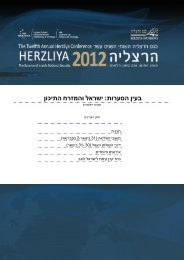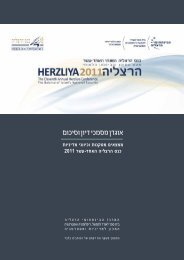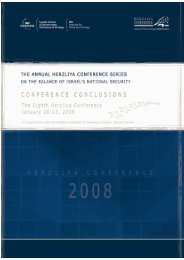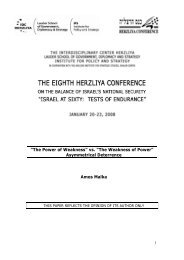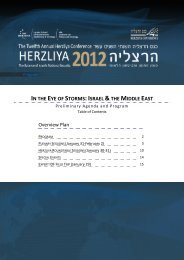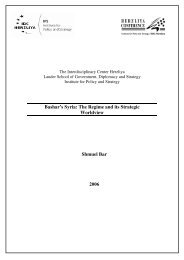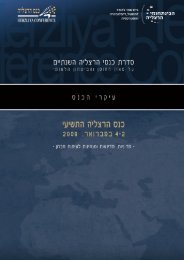Iran: Cultural Values, Self images and Negotiation Behavior
Iran: Cultural Values, Self images and Negotiation Behavior
Iran: Cultural Values, Self images and Negotiation Behavior
Create successful ePaper yourself
Turn your PDF publications into a flip-book with our unique Google optimized e-Paper software.
<strong>Self</strong>-Images <strong>and</strong> StereotypesChivalry <strong>and</strong> Spirituality<strong>Iran</strong>ians today tend to characterize themselves as highly spiritual (rohani), incontrast to the materialistic West <strong>and</strong> Arab world. 68 <strong>Iran</strong>ians see themselves as kind(mehraban), modest (foroutan), sensitive (motavaze’), empathic <strong>and</strong> warm-blooded(hassas, del-suz, khun-garm), 69 socially committed, open-h<strong>and</strong>ed (dast-o del-baaz),<strong>and</strong> loyal <strong>and</strong> constant (vafadaar). 70 These qualities are intimately linked with thepre-Islamic ethos of chivalry (javanmardi), which incorporates such qualities astrustworthiness, truthfulness, <strong>and</strong> honesty in business, integrity, a clear sense ofpurpose <strong>and</strong> identity, perseverance, personal courage, <strong>and</strong> purity. The javanmardam(chivalrous individual) is portrayed as an individualist par excellence, insofar as heobeys his inner compass <strong>and</strong> has no fear of st<strong>and</strong>ing alone against what he sees aswrong. He acts on his principles even at the peril of loosing his own property, <strong>and</strong>defends the weak without regard for the risk to his self. 71 This ethos is held in suchhigh regard that the Imam ‘Ali himself is seen as the model of javanmardi. 72 Aninteresting anecdote which emphasizes this ideal is that of Mossadeq, who, defeated<strong>and</strong> dying, heard a colleague say “how terrible it all turned out,” <strong>and</strong> answered him,“Yes, but at the same time, how marvelous it all turned out.” It is said that Mossadeqsaw himself playing out the roles of the <strong>Iran</strong>ian paradigms of javanmardi: the battlinghero Rostam, the son of Zaal, the noble general Ali, the Lion of Allah <strong>and</strong>, at the sametime, the Imam Hussein, Prince of Martyrs. 73This model gave birth in <strong>Iran</strong> to two parallel paradigms. The most evident is that of<strong>Iran</strong>ian mysticism as expressed in the Sufi movements <strong>and</strong> the dervish personality.The <strong>Iran</strong>ian concept of spirituality is not of ascetism; Shiite Sufism is not ascetic ormonastic <strong>and</strong>, as pointed out above, the great Persian poets promoted enjoyment oflife coupled with awareness of its vicissitudes <strong>and</strong> the need not to fall captive to thevanities of this world. The dervish (darvish) in modern <strong>Iran</strong>ian social typology is aspiritual man who realizes the vanities of material life, enjoys them, but does notallow his self to become enslaved to them. He allows himself to ignore social <strong>and</strong>hierarchical conventions (such as tœ'arof) <strong>and</strong> makes his spiritual well-beingcontingent on his material success. He is not a hermit or an ascetic in the Western orEast Asian sense. He may be completely involved in business or politics but perceivedby his colleagues as a dervish type. 74 In many movies as well as in best-selling novels<strong>and</strong> magazines, there is an expressed aversion to anything ideological, <strong>and</strong> an68 Bateson 262.69 This is especially true about the younger generation. Dr. E. Pardo points out that in many movies, inmagazines, as well as in at least one best-selling novel , there is an expressed disgust of anythingideological, <strong>and</strong> a great interest in dealing with local problems <strong>and</strong> societal ills. There is a search forpacifism <strong>and</strong> a kind of existentialism – they want to live in the “here <strong>and</strong> now” with love, compassion,good food <strong>and</strong> music, <strong>and</strong> heal their wounds from an overly ideological period. The dem<strong>and</strong> by thegovernment to sacrifice youth for nothing in the minefields of the war, <strong>and</strong> executions by therevolutionaries are open wounds. This fact, which is evident to the ruling clerics, st<strong>and</strong>s in directcontradiction to the image of <strong>Iran</strong> which serves as the basis for their political strategies.70 Bateson 262.71 For a definition of javanmardam seeArasteh 26. For the Suffi link to the ancient <strong>Iran</strong>ian concept, seethe site of the Nimutallahi Suffi order: .72 Bateson 263. The identification of the Imam ‘Ali as the “King of Javanmardi” appears frequently indiscussions of <strong>Iran</strong>ian culture on the Usenet.73 Mottahadi 133.74 See Bateson 264–265.17



